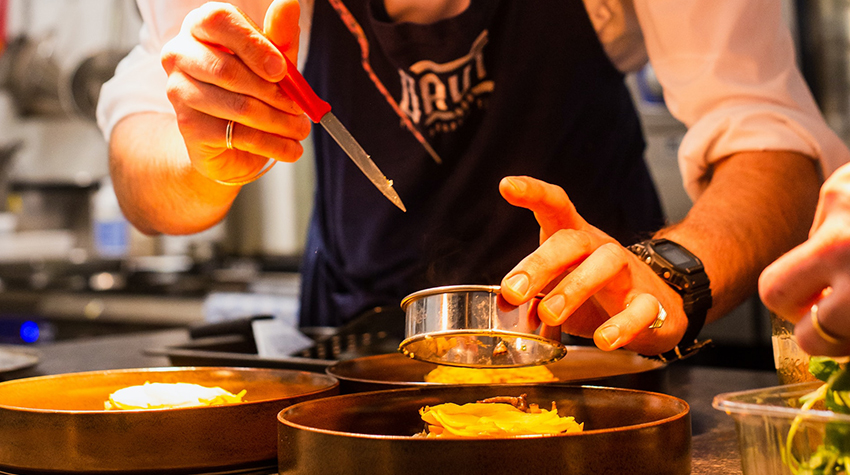Amid the ongoing labor shortage crisis, a promising solution has taken hold. Operators are taking advantage of suppliers’ value-added, prepared or partially prepared ingredients. These items increasingly populate supply order forms as value-added proteins, complex sauces and condiments, roasted pre-cut vegetables, cooked grain mixes, dough and more as a back-of-house lifeline to help facilitate speed-scratch preparation.
With the labor shortage not going anywhere, operators are still looking for ways to combat this issue. In fact, 90% of operators who participated in a Datassential survey said they expect the labor shortage to persist throughout 2023.1 More than a third (36%) cited labor costs as a top challenge, while nearly one-third (31%) cited recruiting and hiring hourly staff.1
While convenient speed-scratch-geared ingredients help control labor costs, they can actually work to your advantage in other ways. Frozen and shelf-stable items, for example, assure more consistent availability along with steady costs. They reduce waste, extend the season on highly seasonal ingredients and help simplify menu development.
To get the most out of your carefully chosen labor-saving ingredients and to ease concerns about losing control over your dish’s distinctiveness, consider these tips.
Source labor-saving, high-quality ingredients
Naturally, sourcing high-quality ingredients is vital, particularly when it comes to your center-of-the-plate proteins. For all your poultry uses across the menu, consider options like pre-breaded and pre-marinated par fry filets and chunks as well as fully cooked diced chicken and strips or oven-roasted sliced turkey breast. Using high-quality pre-breaded and pre-marinated chicken allows any operator to participate in the ongoing crispy chicken sandwich wars while reducing the workload for back-of-house staff.
Some suppliers even offer bone-in and boneless sous vide chicken, which comes fully cooked, so operators only have to heat it up—minimal labor required. This style of preparation provides a moisture-retaining product that doesn’t dry out, which reduces the need for added oils and helps decrease waste. Sous vide chicken also provides consistency and tenderness, as the meat is cooked at a precise temperature in its own juices. Panera Bread boasted of its sous vide chicken when it launched its Chef’s Chicken Sandwiches in March 2022.2
For another quality-sourcing distinctive, scout out value-added proteins that carry the product claims consumers care about and are willing to pay more for. The top three chicken claims that consumers say they are willing to pay more for are clean label (76%), no antibiotics ever (73%) and humanely raised (67%), according to one consumer survey.3 Other mindful qualities to look for are 100% vegetarian fed; raised to a higher standard of animal care; hatched, raised and harvested in the USA.3
Cross-utilize across the menu
Once you’ve found your quality time- and labor-saving ingredients, deploy them across your menu in various dayparts and menu sections. Plug that roasted vegetable medley, protein, sauce or condiment in sandwiches, soups, pizzas, protein bowls or salads.
Convenience items are an important supporting factor for Hillsborough County Public Schools near Tampa, Florida. The large district employs more than 200 foodservice managers and 1,800 employees. One day, chicken may appear in a grab-and-go chicken sandwich as well as shredded in an entrée like Loaded Chicken Tatchos that also utilizes packaged tater tots and nacho toppings.4
Pennsylvania State University is easing labor in two ways. Its foodservice operation has begun purchasing more value-added products. Then, on the service side, it is implementing more self-service for students to add the ingredients themselves to their dishes as garnishes and toppings in lieu of serving complete plates assembled BOH.5
Train your staff
Your purchasing specs designed to save labor in the kitchen could all fall apart in the execution without proper training. Experiment with the use of handouts, videos and hands-on training to discover what works best.
Begin with the culinary basics of mise en place, making sure the staff properly collects, measures and inspects all ingredients. Wherever there’s a chokehold, determine if a value-added product could simplify the process.3
Similarly, as you watch and help the staff prepare the dish or component, keep an eye out for points of congestion and consider adopting products that could alleviate the preparation and time challenges.
Above all, don’t allow labor hurdles to impede your operations. By utilizing value-added products for efficient speed-scratch cooking and implementing thorough training, you can sidestep BOH obstacles while buttering the bottom line with less exertion.
Sources
- Datassential “Labor Deep-Dive Operator Check-in,” January 2023
- “Panera Announces New Chef’s Chicken Sandwiches,” Press Room, Panera, March 22, 2022, https://www.panerabread.com/en-us/press/press-room/panera-announces-new-chefs-chicken-sandwiches.html
- Datassential/Perdue Premium Poultry Claims Consumer Research Report, May 2022
- “Proper Training—A Special Ingredient for Speed-Scratch,” Gordon Foodservice, https://gfs.com/en-us/ideas/proper-training-special-ingredient-speed-scratch/
- Cobe, Pat, “College and Healthcare Chefs Adapt Menus to Meet Operational Challenges,” Foodservice Director, Feb. 3, 2023, https://www.foodservicedirector.com/menu/college-healthcare-chefs-adapt-menus-meet-operational-challenges

